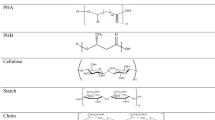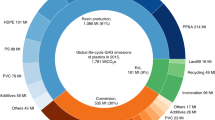Abstract
Bio-based plastics, in which the fossil carbon is replaced by bio/renewable-based carbon, offer the intrinsic value proposition of a reduced carbon footprint and are in complete harmony with the rates and time scale of the biological carbon cycle. Identification and quantification of bio-based content is based on the radioactive C-14 signature associated with (new) biocarbon. Using experimentally determined biocarbon content values, one can calculate the intrinsic CO2 emissions reduction achieved by substituting petrocarbon with biocarbon—the material carbon footprint value proposition. The process carbon footprint arising from the conversion of feedstock to final product is computed using life-cycle assessment methodology. Biodegradability in conjunction with selected disposal systems such as composting and anaerobic digestion offers an end-of-life solution to completely remove the plastic substrate from the environment. Not all bio-based polymer materials are biodegradable, and not all biodegradable polymers are bio-based. Most importantly, complete biodegradability (complete utilization of the polymer by the microorganisms present in the disposal environment) is necessary as per ASTM and ISO standards, otherwise there could be serious health and environmental consequences.






Similar content being viewed by others
References
R. Narayan, American Chemical Society Symposium Series, 939 (2006), C. 18, pp. 282.
R. Narayan, in Renewable Resources and Renewable Energy, M. Graziani, P. Fornasiero, Eds. (CRC Press, Taylor & Francis Group, 2006), C. 1.
ISO 14040 (Principles & Framework) and 14044 (Requirements & Guidelines) standards, International Standards Organization; www.iso.ch.
Association of Plastics Manufacturers in Europe, Brussels, Belgium; http://www.plasticseurope.org/.
E.T.H. Vink, Polym. Degrad. Stab. 80, 403 (2003).
E.T.H. Vink, D.A. Glassner, J.J. Kolstad, R.J. Wooley, R.P. O’Connor, J. Ind. Biotechnol. 3 (1), 58 (2007).
ASTM International, Annual Book of Standards, Standards D 6866; D6400, D6868, D7021 (ASTM International, Philadelphia, PA, 2010), Vol. 8.03; www.astm.org.
U.S. Department of Agriculture Biobased Products Federal Procurement Program; www.biopreferred.gov.
Taking Biobased from Promise to Market (Ad-hoc Advisory Group for Bio-based Products in the framework of the European Commission’s Lead Market Initiative, November 2009); http://ec.europa.eu/enterprise/sectors/biotechnology/files/docs/bio_based_from_promise_to_market_en.pdf.
Japan BioPlastics Association; www.jbpaweb.net/english/e-jbpa.htm.
R. Narayan, in Science and Engineering of Composting: Design, Environmental, Microbiological and Utilization Aspects, H.A.J. Hoitink, H.M. Keener, Eds. (Renaissance Publications, OH, 2003), pp. 339.
P. Galgali, A.J. Varma, U.S. Puntambekar, D.V. Gokhale, Chem. Commun. 23, 2884 (2002).
G. Scott, in Degradable Polymers: Principles and Applications (Kluwer, NY, 2002), Chapter 3.
T.F.J. Ojeda, E. Dalmolin, M.M.C. Forte, R.J.S. Jacques, F.M. Bento, F.A.O. Camargo, Polym. Degrad. Stab. 94, 965 (2009).
R.C. Thompson, Y. Olsen, R.P. Mitchell, A. Davis, S.J. Rowland, A.W.G. John, D. McGonigle, A.E. Russell, Science 304, 838 (2004).
Algalita Marine Research Foundation; www.algalita.org/pelagic_plastic.html.
Y. Mato, T. Isobe, H. Takada, H. Kahnehiro, C. Ohtake, T. Kaminuma, Environ. Sci. Technol. 35, 318 (2001).
E.L. Teuten, J.M. Saquing, D.R.U. Knappe, M.A. Barlaz, S. Jonsson, A. Björn, S.J. Rowland, R.C. Thompson, T.S. Galloway, R. Yamashita, et al., Philos. Trans. R. Soc. London, Ser. B 364, 2027 (2009).
Philos. Trans. R. Soc. London, Ser. B 264 (2009).
Author information
Authors and Affiliations
Corresponding author
Rights and permissions
About this article
Cite this article
Narayan, R. Carbon footprint of bioplastics using biocarbon content analysis and life-cycle assessment. MRS Bulletin 36, 716–721 (2011). https://doi.org/10.1557/mrs.2011.210
Published:
Issue Date:
DOI: https://doi.org/10.1557/mrs.2011.210




